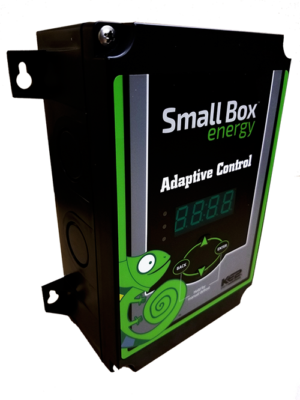Let’s talk Energy Management Systems; we often hear that they save money and maybe don’t understand the in’s and out’s but an essential piece to beginning to understand them is at the baseline…the equipment. We are going to go over typical equipment that is installed as part of an EMS. Knowing how and what is installed will help your overall understanding of the system, how it functions, and how it positively impacts your facility. These pieces of hardware have 2 primary jobs, to collect data from the system that the piece of hardware is connected to, and provide visibility and control to those selected systems.
The Brains
This typically consists of an EMS controller or server that communicates with other pieces of equipment that are installed throughout the facility. In our case, the chameleon™ server enables all of the information received from the facility to be communicated up to the cloud where all of this information is then put onto a dashboard that you can view from any browser or our application on any mobile phone platform. The data transmitted from the server to the devices contains schedules, setpoints, and any other automation commands. That’s why when a change is made in the dashboard you see it reflect immediately in your facility. Think of it like this, let’s say someone stops you on the street and they ask for directions. The only problem is they don’t speak English, you pull out your phone and use a translator which tells the person who doesn’t speak English, in their native language how to get where they need to go. Basically, in this scenario, the phone is the server, and the dashboard is the software on the phone, and it communicates to the rest of the equipment the schedules and setpoints you want.
Meters
There are several different types of meters, but the idea is all the same. We typically work with metering and submetering. A meter is installed in the facility’s electrical box and measures the amount of energy a facility is consuming. At Small Box Energy we also do sub-metering which is a more granular type of metering. Submetering is when a meter collects information about specific systems in the facility like HVAC or lighting so that you can see how much energy is being consumed by lighting on its own and HVAC as well.
Thermostats
Everyone knows what a thermostat does as far as reading and controlling temperatures in a space, the difference between your household thermostat and an EMS thermostat is the EMS thermostats not only read and controls space temperatures but it collects data and sends that data to the server and up to the cloud where it is used in facility analytics. These analytics help facility managers monitor their locations remotely, reduce costs associated with maintenance, as well as energy consumption.
Sensors
Typically wired and wireless sensors are placed throughout the facility to monitor specific areas recording specific sets of data. Below are some of the sensors you can find around a facility with an EMS.
Duct Temperature Sensors
These sensors are placed in the air supply and return ducts to measure duct temperatures. This helps with diagnosing problems with HVAC units, by determining what temperature the unit is pushing out.
Space Temperature Sensors
These sensors are placed, typically, in the center of the room so that it can communicate back to the thermostat and server what the current temperature is in that specific area.
Water Heater Sensor
These sensors are placed at the hot water heater to ensure the temperature of the water coming out is heated to proper health code specs.
Remote Temperature Sensors
These are typically wireless sensors that are used for monitoring food prep areas or small reach in coolers. They collect and report temperature data up to the cloud to ensure the food is HACCP compliant.
Photocell Sensors
These sensors interact with the lighting. They are placed outdoors and communicate to the server the amount of light outside. If it is a cloudy day, they
Lighting
A lighting control panel is usually installed with the EMS, contactors and relays are inside of the control panel itself. With an EMS lighting can be separated into different zones, allowing full remote control of the lighting within a facility. These contactors and relays, communicate to the lighting when it needs to be off and on. Having an EMS allows your lighting to be put on a schedule so you don’t have to rely on people to turn them on and off.
Controls
With some energy management systems, there are niche controls that can be installed and communicate data collection up to the cloud.  Small Box Energy uses an adaptive controller that is installed in walk-in coolers and freezers. The controller collects temperature data from the walk-in and determines when a defrost is needed. Typically most walk-in coolers and freezers defrost on a time schedule, the adaptive controller enables the walk-in cooler to cut down defrosts dramatically, therefore, saving a sufficient amount in energy consumption.
Small Box Energy uses an adaptive controller that is installed in walk-in coolers and freezers. The controller collects temperature data from the walk-in and determines when a defrost is needed. Typically most walk-in coolers and freezers defrost on a time schedule, the adaptive controller enables the walk-in cooler to cut down defrosts dramatically, therefore, saving a sufficient amount in energy consumption.
